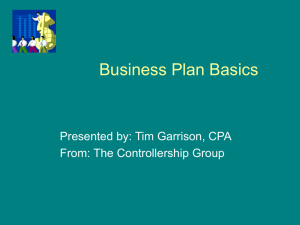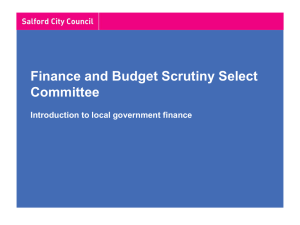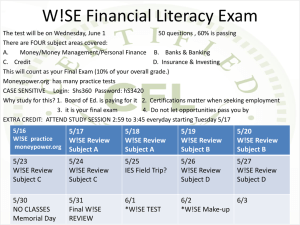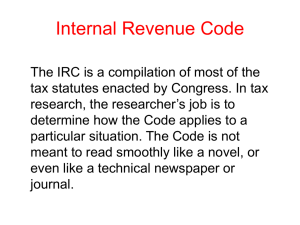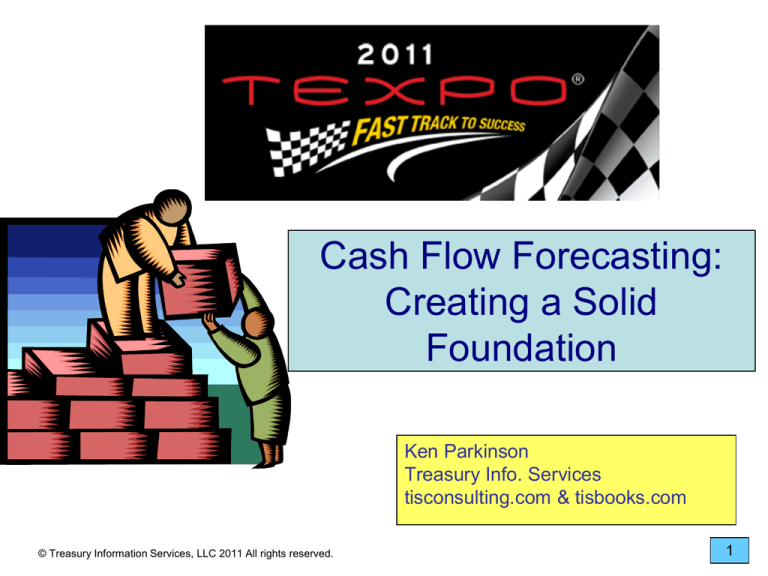
Cash Flow Forecasting:
Creating a Solid
Foundation
Ken Parkinson
Treasury Info. Services
tisconsulting.com & tisbooks.com
© Treasury Information Services, LLC 2011 All rights reserved.
1
Forecasting Setting
Investors (companies) pay [far] less attention
to forecasting than they would if they
borrowed.
Why is this usually the case?
So what to do if you’re an investor?
How is your cash forecast used or regarded?
By the sources of data
By management users
Does anyone seem to care?
© Treasury Information Services, LLC 2011 All rights reserved.
2
Forecasting Variables
1.
2.
3.
4.
5.
6.
7.
Business maturity: more mature, easier to forecast
Historical predictability: similar to previous
Cash flow decentralization: hard to get data, but …
Forecasting period: smaller ones - more accuracy
Accounting influence: the less, the better
Ease of data collection: harder to get – more errors
Org. level of source: too high, bad estimate
© Treasury Information Services, LLC 2011 All rights reserved.
3
The Forecasting Cycle
Sources
estimate &
send data
Data
compiled/r
eviewed
Variances
computed
& fed back
to sources
Cash flow
forecast
prepared
Actuals
compared
to forecast
© Treasury Information Services, LLC 2011 All rights reserved.
4
Forecast Horizons
Daily – rolling 5-days; a necessary part
Weekly – rolling 4-6 weeks; often ignored
Monthly – rolling 12 months; a “staple”
Quarterly – rolling 4-6 quarters; necessary?
Annual – rolling 5 years; a different context
© Treasury Information Services, LLC 2011 All rights reserved.
5
The Problem with Forecasting
How your boss sees it –
“Just push the button.”
The actual nature of your
cash flow forecasting
“challenge”
How do you reconcile this?
© Treasury Information Services, LLC 2011 All rights reserved.
6
So Much Unhappiness!
75-80% lf senior execs do not consider their
cash flow forecasts reliable.
Why is this?
Exactly what do they dislike?
Do firms evaluate forecasting properly?
Or do they try quick fixes?
Or do they give up?
Why don’t many cash flow forecasting systems
work?
© Treasury Information Services, LLC 2011 All rights reserved.
7
Managing Expectations
Whose forecast is it?
What is in your forecast?
Compilation of data
Best guess
Worst case
What are you forecasting?
Senior management? Sources? How about – YOURS?
Cash position
Cash flow (and cash balances)
Why are you forecasting?
For senior management
For strategic planning, esp. financing
© Treasury Information Services, LLC 2011 All rights reserved.
8
Managing Expectations
How often do you need to forecast?
How much do you already know?
Daily? Weekly? Monthly? Annually?
How often can you forecast?
Different ways to forecast?
Financial transactions?
Large operational cash flow items?
Repetitive customer (i.e., “regulars”) payments
How much don’t you know?
Surprises
Variances
Do you rate the sources?
© Treasury Information Services, LLC 2011 All rights reserved.
9
What Bad Forecasts Do to You
Create severe constraints on working capital.
Shorten investment maturities ( = lower yields) or
causes investment liquidity risks (bad guesses).
Increase inefficient short-term borrowing
Overuse credit facilities.
Lines that are never used.
Create excess fund situations in local accounts.
Cause inefficient planning for working capital
management and long-term financing.
Lost opportunities and/or more exposure to ST rate changes
© Treasury Information Services, LLC 2011 All rights reserved.
10
What’s the Best Structure?
Should mirror organization’s cash flows
Benefits of decentralized structure
Centralized vs. decentralized
Can’t ignore potential data sources
Many data points reduce dependence on few
Isolate problems at operating levels
Possible benefit from offsetting errors
Benefits of centralized structure
Fewer points mean easier data gathering
Better control over data, submissions
Ignore local politics
© Treasury Information Services, LLC 2011 All rights reserved.
11
Which Structure?
Top-down
Work from financials
What’s the “top” for daily-weekly-monthly?
Probably better for LT models; maybe monthly
May be statistical model
Bottom-up
Nuts + bolts; no statistical models
More [real] cash flow oriented
Perhaps easier to grasp and use
© Treasury Information Services, LLC 2011 All rights reserved.
12
Top-Down & Bottom-Up
Forecasts
Top Down: Start
with sales
Receivables,
payables, payroll,
inventory, cash all
can be related to
sales
Use historical % of
sales to project,
based on a good
sales forecast
© Treasury Information Services, LLC 2011 All rights reserved.
Bottom Up: Start
with detailed
projections
Get estimates of
components
(receipts,
disbursements, etc.)
Roll up into total
forecast
Which is better?
13
Forecasting Approaches
Top down – for medium-term (i.e., monthly
and up)
Bottom up – for everything up to annual
Is it either-or … or both?
The case for either: simplified system; pick most
accurate, cost-effective
The case for both – redundancy can catch errors
Forecasts should be ‘rolling’
© Treasury Information Services, LLC 2011 All rights reserved.
14
Cash Flow Forecasting System
© Treasury Information Services, LLC 2011 All rights reserved.
Source: Cash Flow Forecasting: A Hands-on Approach
15
Integrate Your Forecasting
Shorter forecasts link to
longer ones
Daily should reconcile with
the 1st week of the weekly
Weekly should reconcile
with 1st month of monthly
Monthly should reconcile
with 1st year of annual
© Treasury Information Services, LLC 2011 All rights reserved.
16
Types of Sources
People
Other company systems
Managers, et al. close to activity
Should be “experts” in expert judgment systems
Key advantage: Minimal human intervention
ERP systems
Transaction-oriented systems
Independent estimates
Financial models, etc.
© Treasury Information Services, LLC 2011 All rights reserved.
17
Operating and Financial Flows
Operating Flows
Possibly many sources =
hard to get
Recurring payments means
history useful
New, identified flows
Planned budget can give
some idea
Base levels may be
relatively easy to estimate,
reducing difficulty
Financial Flows
Reactive flows,
depending on operating
flows
Often has lead time
Fewer sources
History can be guide,
such as rollover levels
LT planning can provide
estimates
Do you try to estimate each one separately?
Why or why not?
© Treasury Information Services, LLC 2011 All rights reserved.
18
History and Predictability
History can be lifesaver
Use in emergencies
Learn from it
Predict patterns from it
Some things are easy to predict
Some are not so easy
Payroll, taxes, major cash flows, debt levels
Payment timing, capex flows, inventory usage
You won’t be able to predict everything.
© Treasury Information Services, LLC 2011 All rights reserved.
19
Whole > ∑Parts?
Unit
Estimate
Actuals
Var. (Act-Est)
% Var.
Division A
6,250
4,025
(2,225)
(55.3)%
Division B
2,350
3,575
1,225
34.3%
Division C
4.560
2,995
(1,565)
(52.3)%
Sub X
1.150
2,275
1,125
49.4%
Sub Y
7,540
8,735
1,195
13.6%
TOTAL
21,850
21,605
(245)
(1.1%)
Note!
© Treasury Information Services, LLC 2011 All rights reserved.
20
Techniques
Don’t expect to use many “sophisticated” techniques.
Think this way
Simple = better?
“Heavier” ones don’t work because …
Short-term (up to 1 yr): data manipulation (management)
Longer-term (1 yr+): more ‘real’ forecasting
Most statistical forecasting techniques are tough.
Lots (and lots) of clean data
Predictability of at least one main factor (usually sales)
Regular “maintenance” and re-testing
© Treasury Information Services, LLC 2011 All rights reserved.
21
Methods to Consider
Method
Uses
Comments
Qualitative
classifications
Short-term
estimates
(day to mon)
Quantitative
classifications
Longer-term
forecasts
(1 yr+)
Causal models
Short-term
projections
(up to 1 yr)
© Treasury Information Services, LLC 2011 All rights reserved.
Expert judgment (Guesstimates)
“Naive" forecasting
Distribution method
How accurate?
Decomposition models
%-of-sales – future
based on past
• Tough to create good models
•
•
•
•
•
Economic models
Future based on outside factor
Good for established cash flows
22
Application of Distribution Method
Receivables or payables projection models
Use history to predict clearance factors
Influenced by Pareto’s 80/20 rule
AR or AP
ageing
“clearance” factors applied
Estimates by period
© Treasury Information Services, LLC 2011 All rights reserved.
23
Analyzing Roll-over Rates
Track your liquidity “balances” regularly.
A spreadsheet will do.
Go back and find history if necessary.
Compute the average roll-over rates by month or most reliable
period for ST investments and debt separately (if both present).
Look for changes in net position (indicators of cash flow
movements.
Are they recurring? How predictable are they?
Look for the minimum and maximum.
Incorporate into your forecasting system and predict usage of
lines or potential excess cash situations.
Track continuously.
Monitor and modify as necessary.
© Treasury Information Services, LLC 2011 All rights reserved.
24
Roll-Over Rates
max
$M
min
Time
min
© Treasury Information Services, LLC 2011 All rights reserved.
max
min
25
Per cent of Sales
CASH FORECASTING WITH PRO FORMA FINANCIAL STATEMENTS
Assumed
Fixed Assumptions:
Depreciation (% of F/A)
Div idends
Notes Will Be Inc/(Dec)
f or Next Y ear by
Interest Rates on:
Notes
Bonds
Projected Sales ($)
5.00%
6.75%
$2,000
Variable Percentages:
COGS as % of sales
Selling/Admin Exp
Cash as % of Sales
A/R as % of Sales
A/P as % of Sales
Inv entory as % of Sales
Taxes
Additions to Fixed Assets ($)
Cash
Accounts Receiv able
Inv entory
Net Fixed Assets
Total Assets
Actual
$250
300
200
1,000
$1,750
Projected
$333
400
267
1,045
$2,045
Accounts Pay able
Notes
Bonds
Common Equity (incl R/E)
Tot Liab & Equity
$350
100
450
850
$1,750
$467
100
450
996
$2,012
Actual
$1,500
(850)
(275)
(100)
(10)
265
106
$371
Projected
$2,000
(1,133)
(367)
(55)
(35)
410
(164)
$246
5.00%
100
56.7%
18.3% (Enter % to
16.7% over-ride
20.0% computed
23.3% values.)
13.3%
40.0%
100
%-of-sales
BALANCE SHEET
Projected
financials
INCOME STATEMENT
Sales
COGS
Selling & Admin Exp
Depreciation
Interest Exp
Income Bef Taxes
Taxes
Net Income Bef ore Div s
© Treasury Information Services, LLC 2011 All rights reserved.
Difference
$33
New debt
“Freeze”
Notes to
compute new
debt figure
26
Master Maturity Schedule
Principal only shown
($000)
By Type
05/11/11
05/12/11
05/13/11
05/14/11
05/15/11
Mon
Tues
Weds
Thur
Fri
500
1,000
1,500
2,000
2,500
1,000
1,500
500
1,000
2,000
2,000
1,000
Current
Beyond
Week 1 Week 2 Week 3 Week 4
ST INVESTMENTS
Repo
CP-01
CD-01
CP-02
CD-02
CP-03
750
1,500
2,500
500
2,000
1,000
1,000
2,000
1,000
4,250
3,500
8,500
5,750
5,000
1,000
2,500
1,750
1,500
500
500
2,500
2,500
3,000
2,000
5,500
5,300
4,900
5,000
3,500
Details (actuals)
ST BORROWING
CP
Bank-01 line
Bank-02 line
500
450
420
5,000
2,500
2,500
1,300
1,000
1,000
1,200
750
750
2,500 10,500
1,500 6,200
1,500 6,170
2,500
1,000
1,000
2,800
1,300
1,300
1,000
750
750
10,200
7,000
7,000
5,675
4,475
6,625
2,200
1,450
1,250
5,250
5,120
7,500 26,500
7,300 20,345
1,250
1,200
2,500
2,400
3,600
3,500
85,600
83,460
2,500
4,000
2,500
5,000
2,500
7,500
1,370
5,000
10,000
4,000
3,300
FX
Proceeds (sales)
Purchases
LT TRANSACTIONS
New /rolled over LTD
Stock divi pmts
4,250
LTD Repay ments
links
0
13,250
7,500
50,000
12,750
Summaries (links)
*** Totals
ST INVESTMENTS
ST BORROWING
5,000
2,700
6,500 28,000
5,500 22,870
© Treasury Information Services, LLC 2011 All rights reserved.
6,500
4,500
5,500
5,400
5,500
2,500
24,200
24,200
27
Variances
Measuring is not enough: You need reasons.
Typically measure latest estimate (day, week, month)
Measure several variances
Should be best one
Why is this insufficient?
Several intervals
Gives you a better picture
How to “fix” variances
Communications
Adjustments to current and/or future forecasts
© Treasury Information Services, LLC 2011 All rights reserved.
28
Charting Variances
Note change in direction.
Net cash flow for 4 mos.
$
Note shift here.
© Treasury Information Services, LLC 2011 All rights reserved.
29
Variances for Intervals
Variances
Net
cash
flows
1-mo 3-mo 6-mo
1,170
1,600
(400) (680)
700
1,100
400
200
900
3,600 7,600
(900) (2,700) (4,600)
500
1,500 4,000
1,500 4,500 2,700
(300) 700
2,300
200
600
5,900
200
600
(3,400)
731
1,818 4,357
Jan
Feb
Mar
Apr
May
Jun
Jul
Aug
Sep
Oct
Nov
Dec
Avg
Avg
1.75% 4.34% 10.40%
%-Var
© Treasury Information Services, LLC 2011 All rights reserved.
30
Variance vs. History
%-VARIANCE FROM AVERAGE
(Est-Avg)/(Avg)
Jan
Receipts
Staff deposits
24.1%
Chicago lockbox
-37.5%
Atlanta lockbox
-16.7%
Maturing investments
-41.5%
Customer ACH payments -6.3%
Miscellaneous cash inflows 3.6%
International wires
60.0%
** TOTAL RECEIPTS
-14.9%
Feb
Mar
-17.2%
24.1%
-43.8% -56.3%
0.0%
16.7%
-12.2% -41.5%
-25.0%
12.5%
9.6%
21.8%
140.0% -100.0%
-14.5%
-9.7%
Apr
May
Jun
65.5%
-25.0%
0.0%
-41.5%
-25.0%
3.6%
-20.0%
-9.3%
24.1%
-6.3%
-16.7%
-12.2%
12.5%
-8.6%
60.0%
-4.9%
-17.2%
0.0%
-33.3%
46.3%
-6.3%
-8.6%
60.0%
-4.9%
68.0%
-14.3%
0.0%
-34.1%
-100.0%
18.2%
-17.2%
11.0%
8.0%
71.4%
0.0%
-7.7%
-100.0%
36.4%
65.5%
21.8%
39.4%
69.4%
Disbursements
Controlled disbursements 20.0%
8.0%
44.0%
32.0%
Payroll: checks
71.4%
-14.3% -14.3% -14.3%
Payoll (checks)
0.0%
0.0%
0.0%
0.0%
ST debt maturing
-34.1%
-7.7%
18.7%
-7.7%
LT debt repayment
-100.0% -100.0% -100.0% -100.0%
Miscellaneous cash outflows
-54.5% -36.4% -18.2%
0.0%
Wires (outgoing)
-17.2%
24.1%
65.5%
-58.6%
** TOTAL DISBURSEMENTS -44.2% -31.1% -11.6%
-3.4%
*** NET CASH FLOW
-96.4%
© Treasury Information Services, LLC 2011 All rights reserved.
-60.7%
-14.9%
7.2%
31
Conclusions
Many items may lower your overall error rate, but …
How are you doing individually?
What do you do?
Once you receive forecasts from sources –
the forecast becomes yours
Act accordingly
Watch out for statistical methods.
They are suited to LT forecasts.
You won't be able to predict everything.
But you want to be in the ball park.
And remember -- it’s just a forecast!
© Treasury Information Services, LLC 2011 All rights reserved.
32
Any Questions?
© Treasury Information Services, LLC 2011 All rights reserved.
33

![Your_Solutions_LLC_-_New_Business3[1]](http://s2.studylib.net/store/data/005544494_1-444a738d95c4d66d28ef7ef4e25c86f0-300x300.png)
